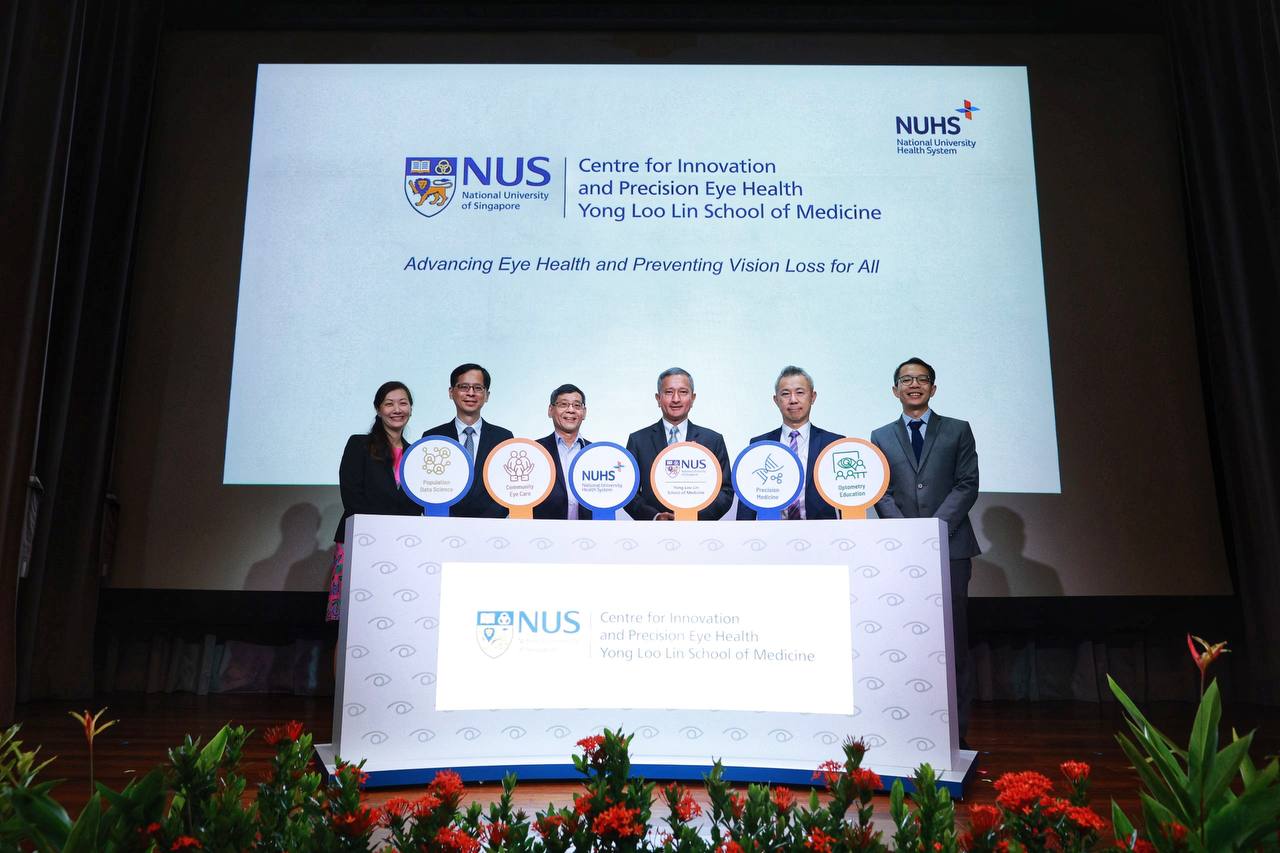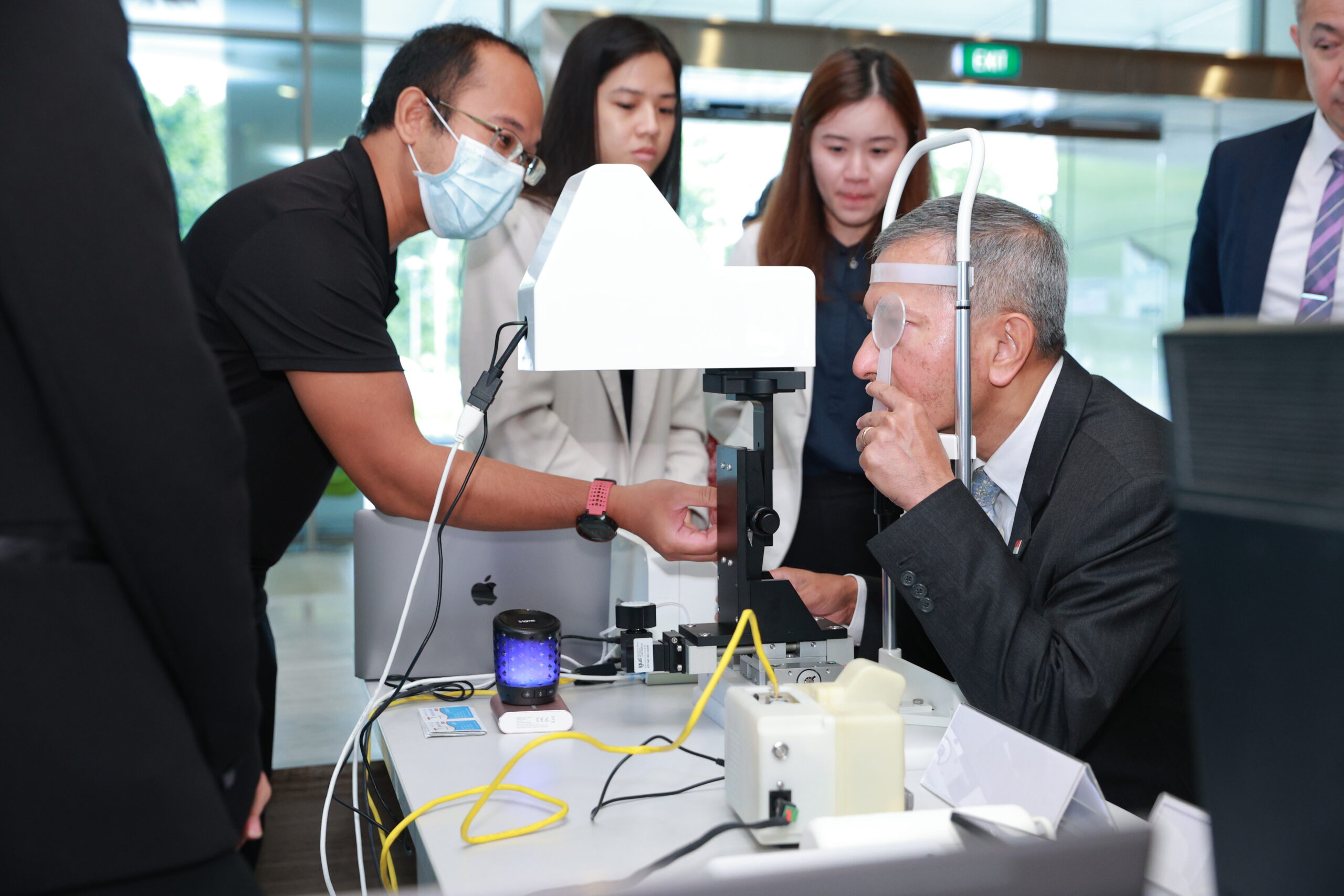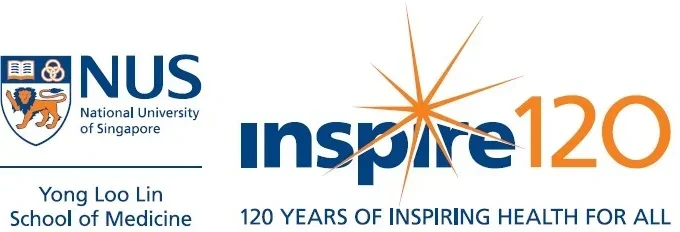Zeroing In On Population Eye Health Care
Published: 25 Mar 2023

The new Centre for Innovation and Precision Eye Health at NUS Medicine was launched on 25 Mar 2023. The event was graced by the Guest-of-Honour, Minister for Foreign Affairs, Dr Vivian Balakrishnan (third from right).
As Singaporeans age, the increasing incidence of eye disease calls for community-based eye healthcare to more effectively prevent, detect and treat vision problems in the population.
Such an approach would draw on large scale population health metrics to proactively and pre-emptively spot patterns and trends in Singaporeans’ general eye health. These metrics, powered by novel medical devices, artificial intelligence (AI) and drawing on population-based data, will help doctors and health care planners to marshal and site the necessary resources where they are needed.
At the same time, the comprehensive picture provided by the database will help guide research work that is aimed at bringing the most effective screening and treatment options for patients, according to disease severity and the risk of developing chronic eye conditions. These are the aims of the newly-established Centre for Innovation and Precision Eye Health that is being set up by the Yong Loo Lin School of Medicine at the National University of Singapore (NUS Medicine) and National University Health System (NUHS).
Said Dean of NUS Medicine, Professor Chong Yap Seng, Lien Ying Chow Professor in Medicine, “This Centre is an example of the translational research work that we believe will help to transform the current healthcare ecosystem in Singapore to one that prioritises preventive care. We want to do this by detecting and identifying early stages of eye diseases, particularly when the population of Singapore is rapidly ageing and more are at risk of developing chronic diseases. Through the use of evidence-based innovation, AI-powered digital infrastructure and scalable community-based care models, this Centre will help to meet the increasing demands of eye care in our ageing population.”
Creating greater accessibility to community-based eye health care
The Centre has introduced the development of novel, portable eye screening and monitoring medical devices for people to get eye check-ups more regularly and conveniently in the primary care settings such as polyclinics or optometrists at the optical shops in the future.
These medical devices are AVAT or Automated Visual Acuity, which measures eye ability to distinguish shapes at a distance, SUPRA or Smart, User-friendly Portable Reliable Automated perimetry device which tests visual fields, and STOP or Self-Tonometry device for monitoring of Intra-ocular pressure that measures eye pressure through the eyelids. These devices address the unmet needs of increasing demand to decentralise the current care model of conducting eye screening and monitoring of eye diseases, and scale up the testing phase with minimal costs and manpower resources.

Guest-of-Honour, Minister for Foreign Affairs, Dr Vivian Balakrishnan, tried out the Automated Visual Acuity Test (AVAT) at the launch event. The AVAT is a self-administered, automated kiosk that tests the ability of the eye to distinguish shapes and object details at a distance.
Funded by Temasek Foundation, these portable medical eye screening devices were developed by the Department of Ophthalmology at NUS Medicine and have undergone multiple refinements at the National University Hospital. According to Associate Professor Victor Koh, the Head of Department of Ophthalmology at NUS Medicine, “Through upskilling courses and pathways, optometrists will be equipped with the necessary skill sets to detect early signs of eye diseases as first responders in the community.”
Developing new models for detecting eye diseases via AI-powered Research
In addition to new portable devices, the Centre will leverage state-of-art big data analytics and AI technologies to develop more cost-effective algorithms to screen and detect eye diseases. Professor Cheng Ching-Yu, the Centre’s Director, and his team have developed retinal photo-based AI algorithms to detect visual impairment and cataract and to predict biological age and the risks of cardiovascular diseases. The Centre will be conducting clinical trials in the community to evaluate the real-world performance of these AI models. “We aim to deliver precision population health for major age-related eye diseases by providing the right intervention to the right population at the right time. With advances in AI and digital technology, we now have better capabilities and infrastructure to devise and adopt AI algorithms which will bring about important insights into the hidden pattern of diseases that may otherwise be obscured by limitations of traditional analytic tools,” said Professor Cheng.
Introducing precision gene and cell therapy for blinding retinal diseases
At the same time, research at the Centre will draw on genomic data to develop precision gene and cell therapy for currently untreatable and blinding retinal degenerative eye diseases. Over one billion people globally suffer from visual impairment, making it a major health burden. The World Health Organization (WHO) identifies age-related macular degeneration (AMD) and Inherited retinal dystrophies (IRDs) as the most critical retinal eye diseases, which affects an estimated 196 million people and two million people per year respectively.
“Visual impairment is ranked as one of the top disease burdens, aside from obesity, diabetes and hypertension. We hope to introduce new collaborations and create ground-breaking advancement in precision medicine, specifically gene and cell therapies to provide effective treatments for those suffering from visual impairment to recover their sight, and regain their independence and confidence again,” said Assistant Professor Su Xinyi, co-Director of the new Centre and consultant ophthalmologist at the National University Hospital. Assistant Professor Su also actively works on stem cell therapeutics in the treatment of degenerative eye diseases.
Read the press release here.
News Coverage
- “Eye-care kiosks for glaucoma, cataract tests to be rolled out at more polyclinics”, The Straits Times, 25 March 2023
- “缩短看诊时间 本地研发便携式仪器方便公众检验眼睛”, Lianhe Zaobao, 26 March 2023
- “New screening devices to make eye exams more accessible | Video”, Channel NewsAsia, 25 March 2023
- “社区提供眼科护理服务 可直接转介眼疾病患到医院”, Channel 8 News, 25 March 2023
- “社区提供眼科护理服务 可直接转介眼疾病患到医院”, 8World News, 25 March 2023
- “国大杨潞龄医学院设立创新与精准眼科研究中心”, SGNews, 26 March 2023
- “Pusat kesihatan mata manfaatkan AI dan sains data (Eye health centers leverage AI and data science)”, Berita Mediacorp, 25 March 2023
- “Kios jagaan mata bagi ujian glaukoma, katarak dirancang bagi lebih banyak poliklinik (Eye care kiosks for glaucoma, cataract tests are planned for more polyclinics)”, Berita Harian Online, 25 March 2023
- “பலதுறை மருந்தகங்களில் கண் பராமரிப்புக் கூடங்கள் திட்டம் (Eye-care kiosks for glaucoma, cataract tests to be rolled out at more polyclinics)”, Tamil Murasu Online, 26 March 2023
- “Glaucoma tests at polyclinics, gene therapy research, announced at launch of new eye health centre”, Red Hot Singapore, 25 March 2023
- 26 March 2023, The Straits Times [Print], Page A5, Eye-care kiosks for glaucoma, cataract tests to be rolled out at more polyclinics
- 26 March 2023, Lianhe Zaobao [Print], Page 7, 缩短看诊时间 本地研发便携式仪器方便公众检验眼睛
- 26 March 2023, Shin Min Daily News [Print], Page 4, 本地研发 便携式仪器验眼 缩短看诊时间 (Locally invented portable optometry device helps shorten consultation time)
- 26 March 2023, Tamil Murasu [Print], Page 2, பலதுறை மருந்தகங்களில் கண் பராமரிப்புக் கூடங்கள் திட்டம் (Eye-care kiosks for glaucoma, cataract tests to be rolled out at more polyclinics)
- 25 March 2023, Channel 5 News, Improving eye care – new centre will harness artificial intelligence to treat eye diseases
- 25 March 2023, Suria news, Improving eye care – new centre will harness artificial intelligence to treat eye diseases
- 25 March 2023, Vasantham news, Improving eye care – new centre will harness artificial intelligence to treat eye diseases


